Opinion & Analysis
Korea’s answer to help grow the game
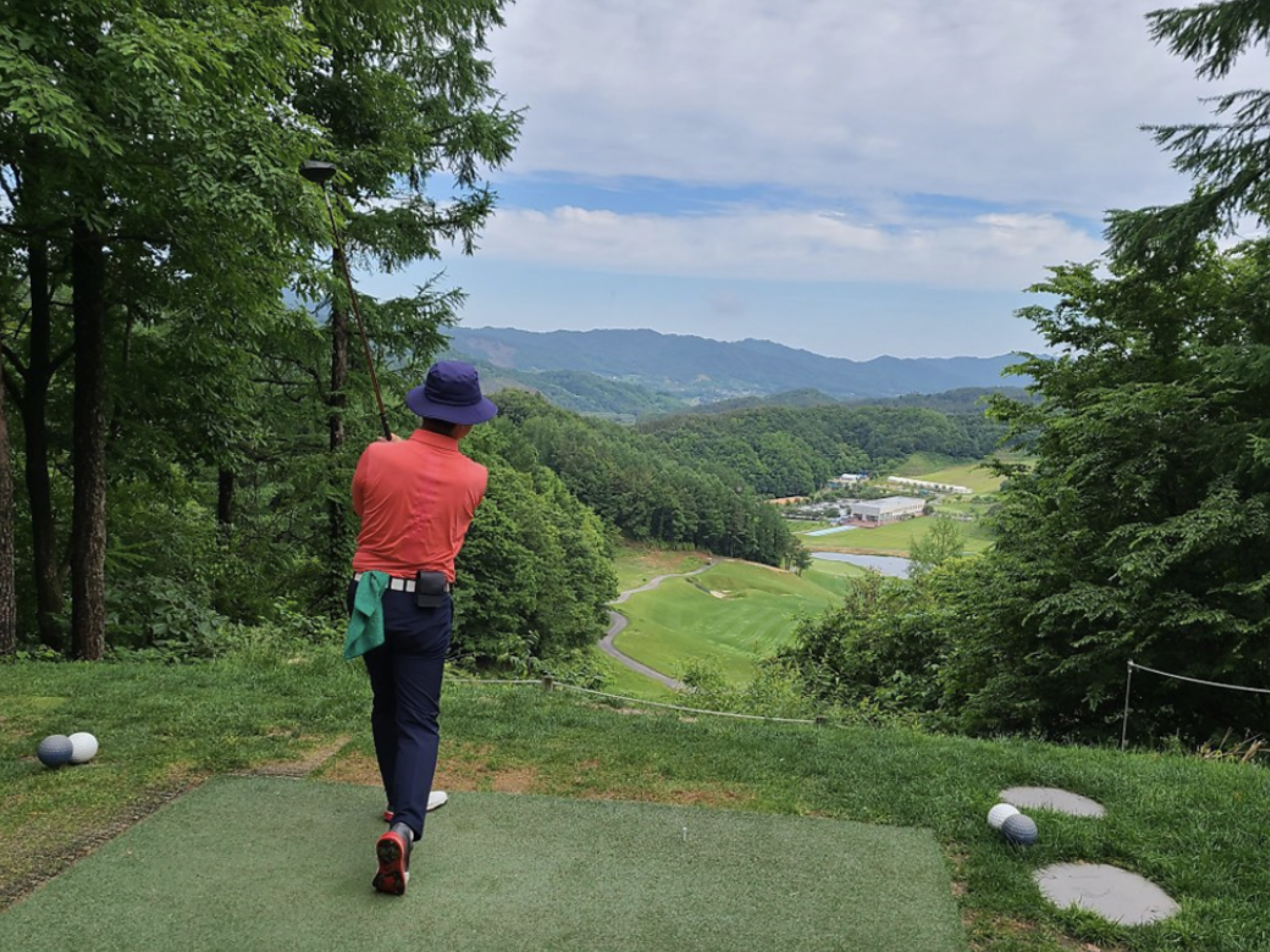
When the golfing world was first introduced to Mark Broadie’s Strokes Gained Index (SGI) in 2011, it forever changed the way we look at the game. In direct contrast to legendary Bobby Locke’s iconic phrase “drive for show, putt for dough,” the new method showed that driving the ball well was actually the bigger factor in lowering scores.
At first, I recall thinking that it couldn’t be right. After all, the longest drive and the shortest putt each count the same one stroke, right? But then again, where are you more likely to make a birdie from if your ball is 50 yards and 150 yards from the pin, respectively?

Should the new saying be “Putt for show, Drive for dough?”
Even before Broadie’s method showed the advantages of longer drives, nearly all club and ball manufacturers have been focused on marketing distance. In response, many golf courses tried to lengthen the course to keep the game challenging. But no matter how long golf courses became, long bombers like Bryson and Dustin continued to make short work of them reaching “monstrous” par 5s in two with an 8- iron. It was only a matter of time before golf’s governing bodies declared that things had gone too far.
- Related: Golf in Korea during COVID-19
I understand where the USGA is coming from. But surely there are other ways to make professional golf more challenging than limiting golf ball distance for everyone. After all, why penalize average Joes like me who can barely drive 250? Instead, let’s make the course set up more difficult for professional tournaments and let the rest of us continue our valiant struggle with all the help we can get.
With all the heated online arguments for and against USGA’s stance on distance, however, I found it odd that it has never been an issue here in Korea. In fact, whenever I tried to discuss the topic and how it's dividing golfers in the West, no one here seemed to bat an eye. I too soon came to dismiss it as a non-issue, but after subconsciously mulling about it for a while, I came up with an interesting theory.
Could it be that the courses here are already hard enough without having to add extra sandbags around our ankles?
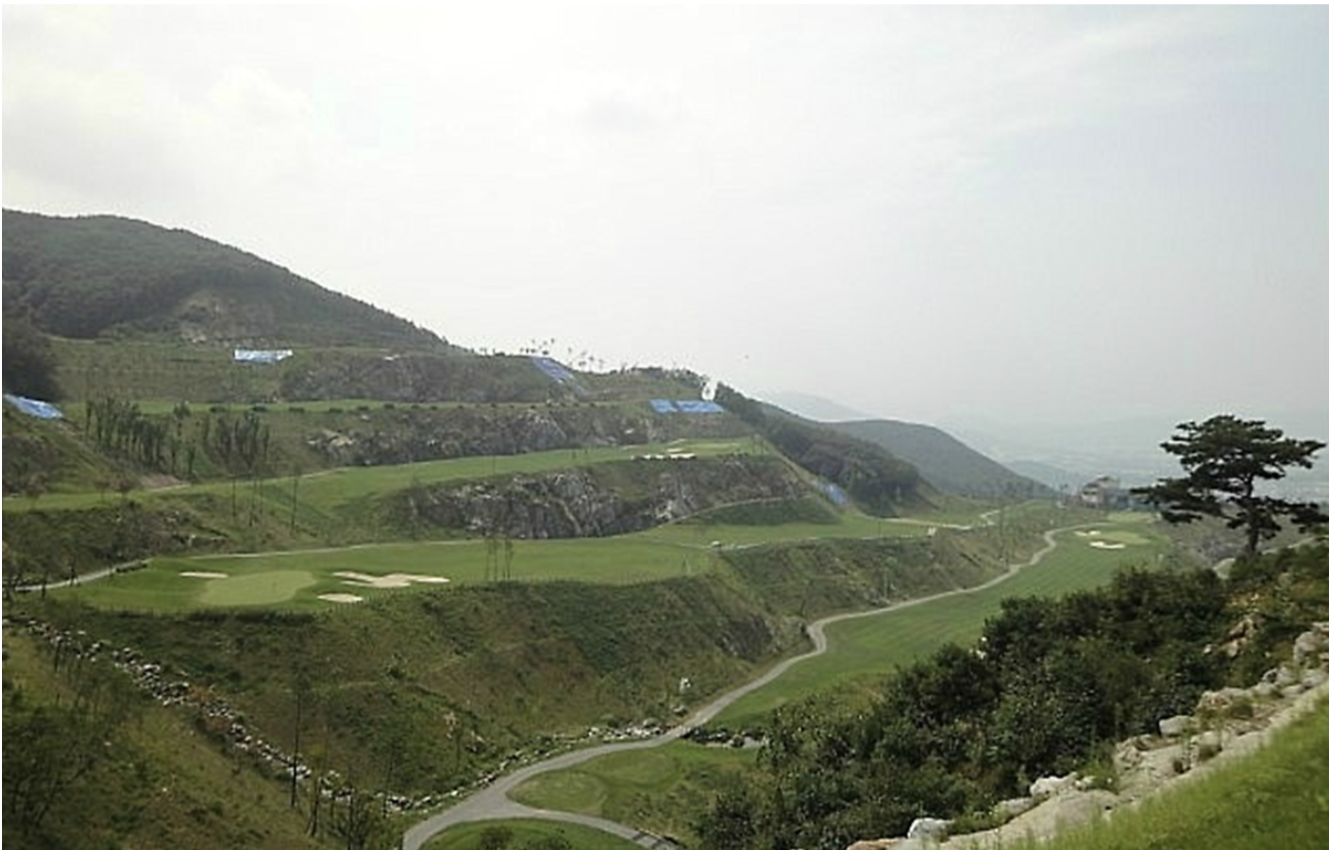
Flat land for building a golf course is rare in Korea
To be sure, I’m not trying to compare Korean courses to beasts like Bethpage Black or Whistling straits. However, it is my contention that most Korean courses have very narrow fairways and an over-abundance of penalty areas in comparison to their Western counterparts. As such, Korean courses support my claim that difficult setups can make the game plenty challenging without limiting equipment distance. Plus, some of the course features and local rules here also act to help grow the game by speeding up play considerably.
Size Matters
To give you some perspective on size, South Korea is a small peninsula about the size of Indiana with mountains covering 70 percent of the country. As a result, the majority of 550+ golf courses here are carved out on top or steep sides of mountains. A typical golf hole here features a hill along one side of the hole and a steep drop-off on the other side. So if a tee shot happens to stray a little off the narrow fairway, the ball is usually declared to be out of bounds or lost.
When I first began playing here in 2001, my first impression was that the courses seemed relatively short and easy. Back in Canada, if a tee shot strays onto the adjacent hole or under a tree, it would simply make for a fun and challenging attempt to scramble for par, right? Nope. Not here. Uh-uh. With almost every hole lined on both sides with OB or hazard stakes, I realized quickly that golf here required a very different approach than what I was used to.

Most of Korea’s 550+ golf courses are carved on top or sides of mountains.
At first, there seemed to be no reason or rhyme as to why the courses had so many penalty areas. In particular, what frustrated me most was having an easy wedge over relatively short trees from an adjacent hole; only to be told it was out of bounds. What good is the ability to pull off amazing Seve-esque recovery shots if I’m not even given a chance to attempt them in the first place?
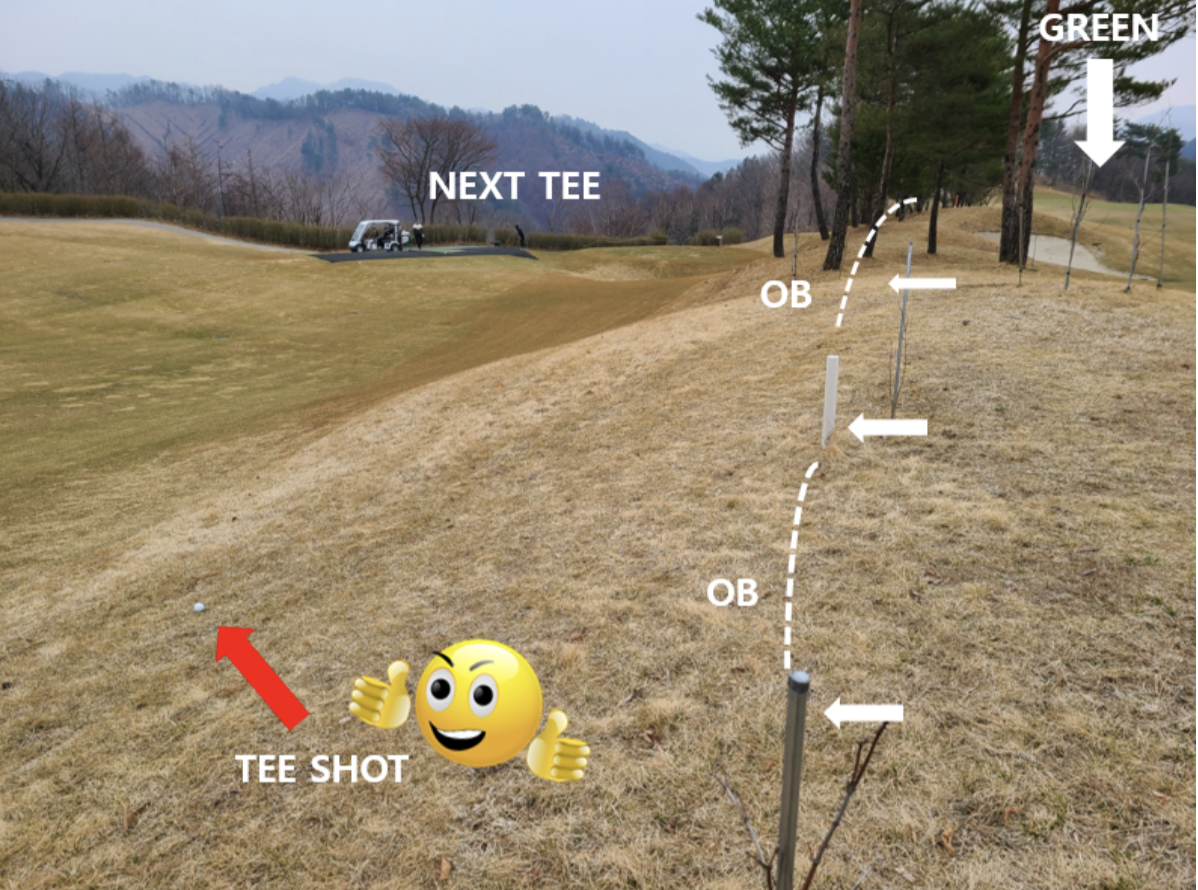
Easy 9 iron to the green? Nope. OB for D-bogey or worse.
Inevitably, I soon developed a severe case of the driver yips in trying to keep my ball in play. No matter how I tried, every round would have at least two or three balls out of bounds. My handicap quickly grew from being a toddler to the legal drinking age, and my foursome began to doubt I had ever broken 80 before. Likewise, my preference for long-distance quickly took a backseat in favor of accurate shot-making.
To be sure, I’m not suggesting a dozen new penalty areas be added or your golf courses are built on the sides of mountains. I’m just saying that before any definitive decision is made on the equipment side of golf, I hope the powers that be can first explore diverse course setups at iconic tournament courses to challenge the best players in the world. After all, there are so many more amateur golfers than professionals, and we certainly need all the help we can get.

Just your typical tee shot with 90 meter drop, OB on both sides to a sloping fairway. No pressure.
Course setup to grow the game?
Aside from an abundance of OB stakes, Korean courses also have several features and local rules which may baffle newcomers. Even though some of them may not be welcomed in all parts of the world, and are certainly not practiced for pro tournament play here, they have undeniably helped the game grow in Korea by speeding up play immensely.

OB tees to save time and ego.
Your home course probably has a drop area on par 3s where hazards come into play. The same applies here but with one big difference in that, we also have a designated drop area for par 4s and par 5s. You see, when a tee shot’s fate is in question, amateur golfers are urged to play from a special set of tees 220~250 yards ahead. So, rather than playing a provisional ball, the golfer would be playing their 3rd or 4th shot from these forward tees, depending on whether the ball landed in a
hazard or out of bounds.
Although it took a bit of getting used to, I have found this common local rule to help in two ways here. One, it speeds up the pace of play considerably; and two, it helps to preserve the sanity of golfers from having to re-tee with the potential to hit multiple balls out of bounds.
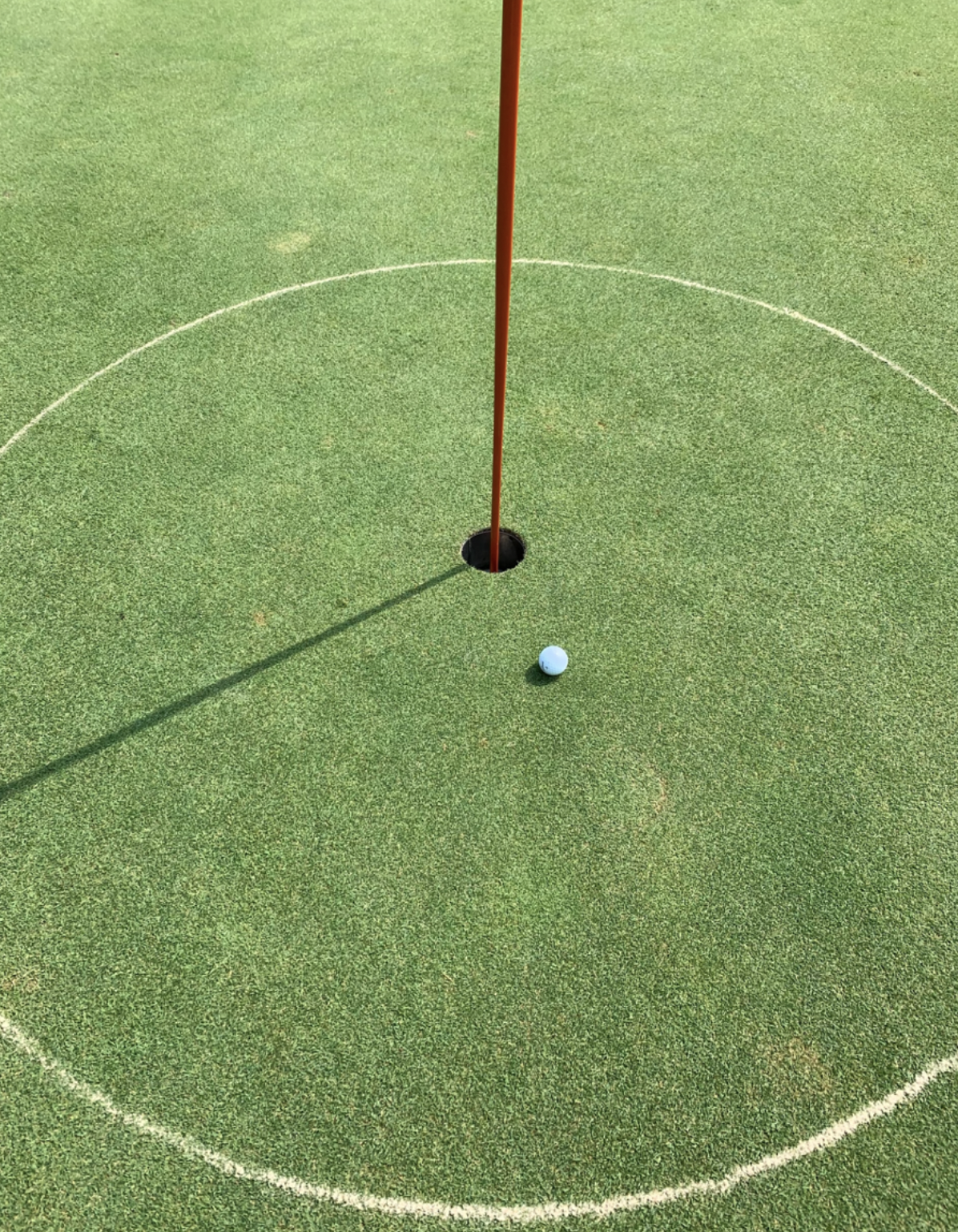
Not gonna lie. These look great with hard breaking downhill putts.
I can’t recall if I’ve ever encountered an actual gimme circle back when growing up in Canada, but more often than not, golfers here will see a circle drawn around the hole cup ranging in radius from 1~1.5m. The obvious intent is that if the ball ends up inside the circle, the next putt is considered a gimme, and the golfer can pick up the ball. At the start of a round, the foursome can decide whether they will put the circle in play or hole out each time.
For the purist, the length of the gimme circle may seem absurd, but I can attest that it does wonders for one’s ego and score, and keeps arguments to a minimum. Of course, it also helps to speed up play.
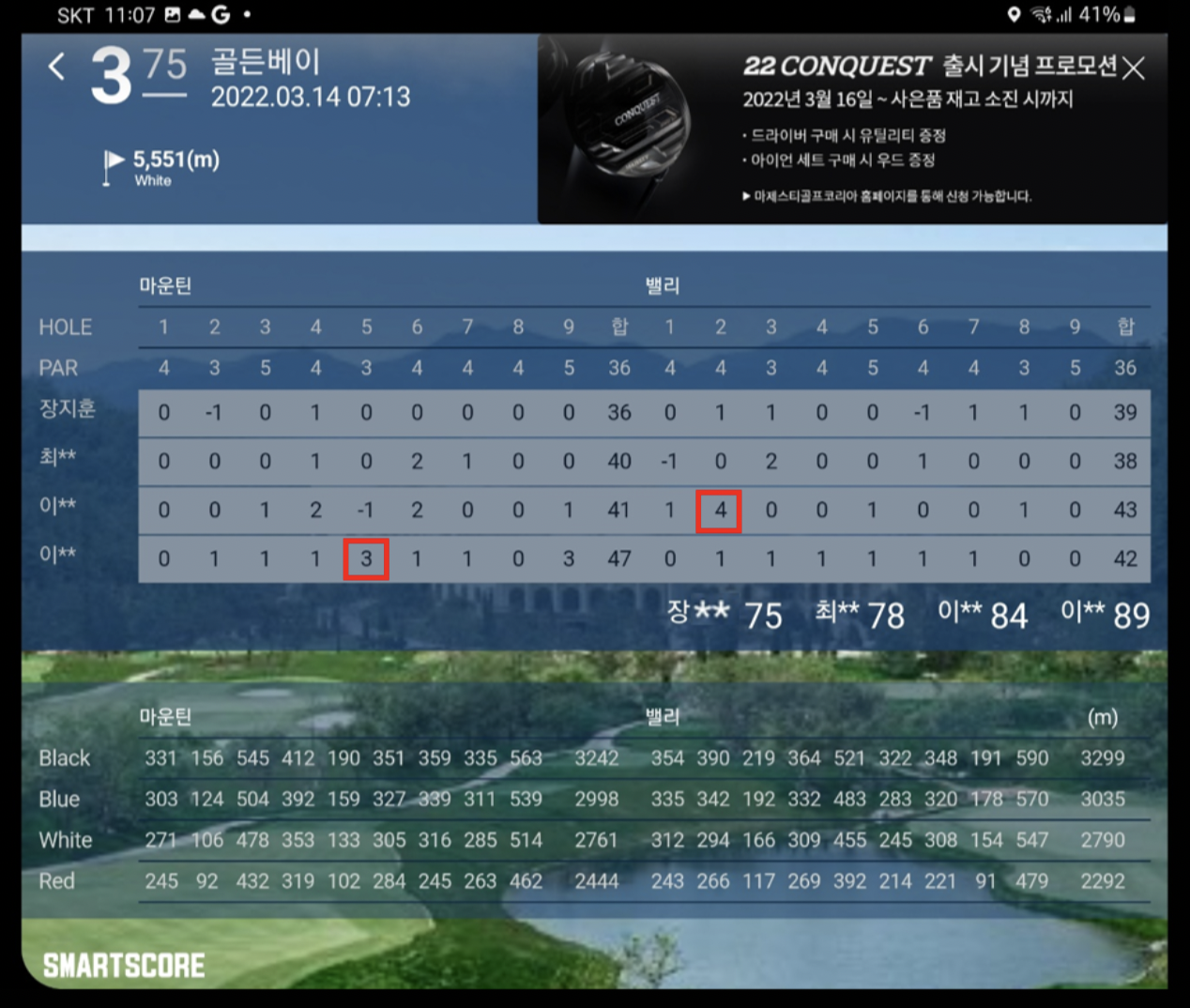
Notice something with the first and last holes too? That’s for another time.
Another aspect of golf that may raise some eyebrows out there is our concept of “double par”. It is common practice here for strokes to be counted only up to double the par of the hole played. For example, the maximum score on a par 3 would be a triple, a quadruple for a par 4, and a quintuple bogey for a par 5.
So even if you were to dunk three balls at the treacherous 17th hole at Sawgrass, the maximum score would be a six (provided that the course was in Korea). Wild stuff, huh? Can you imagine how many pros would love to settle for a triple at that hole during the Players Championship this year?
Again, the main idea for this practice is to speed up play, save some golf balls, and keep one’s handicap comfortably vague for sandbagging purposes.
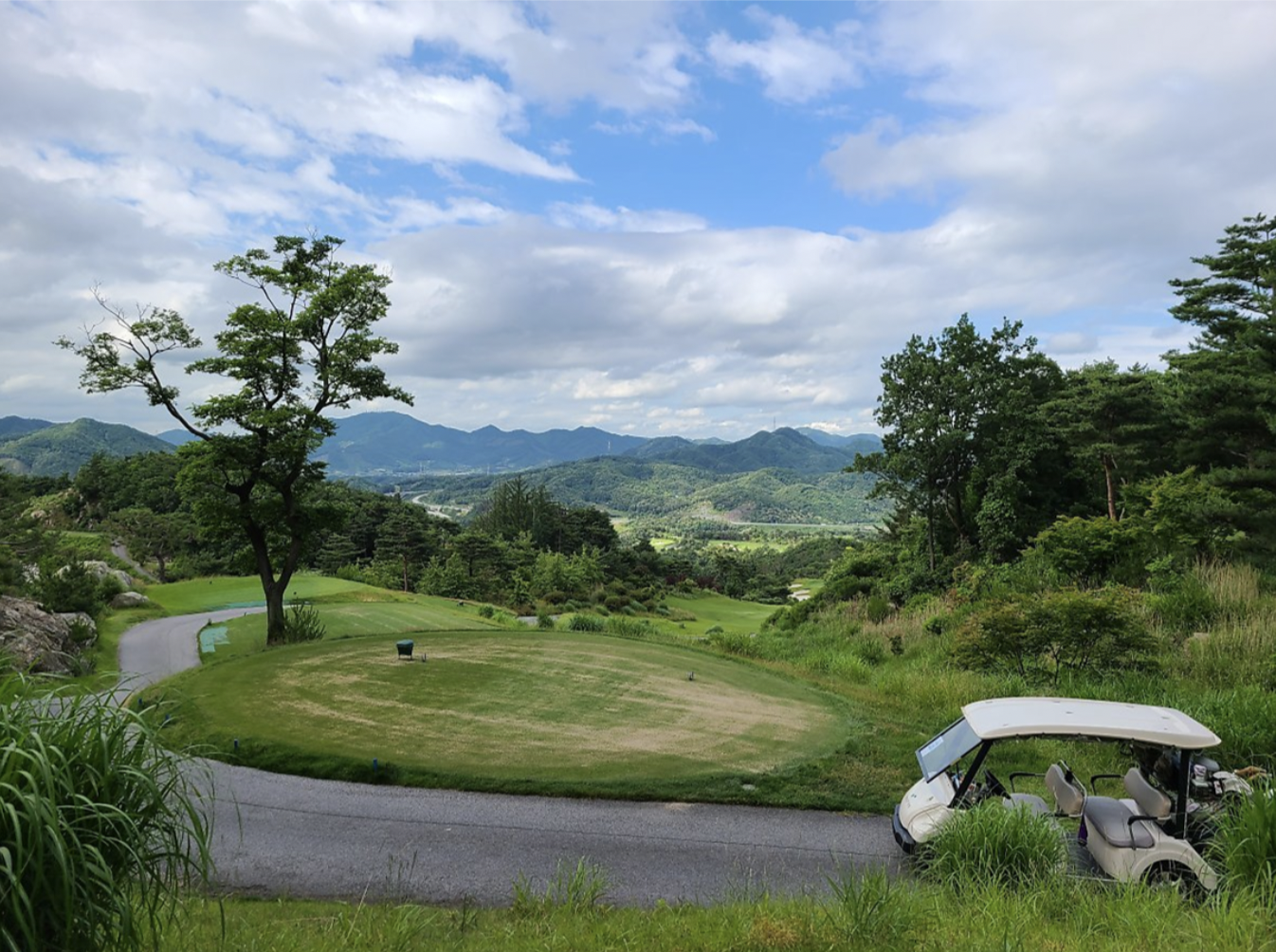
Carts prevent cardiac arrest.
Last but not least, over 90% of Korea’s public and private courses require golfers to ride a 5-person power cart and employ a caddie with the cost shared among the foursome. What if one doesn't want to ride a cart, or use the services of a caddie?
Unfortunately, it is not a choice at these courses but there are some darn good reasons too.
First, the mountainous topography of Korean courses makes it incredibly hard to walk and play18 holes. The distance between holes can literally be a mile over incredibly steep hills or winding paths down a side of a mountain. So unless you are training for the Iron Man triathlon, there is no shame in riding the cart here. Even for a professional tournament, I understand that special measures are taken to protect the players and caddies in case such a course is played.
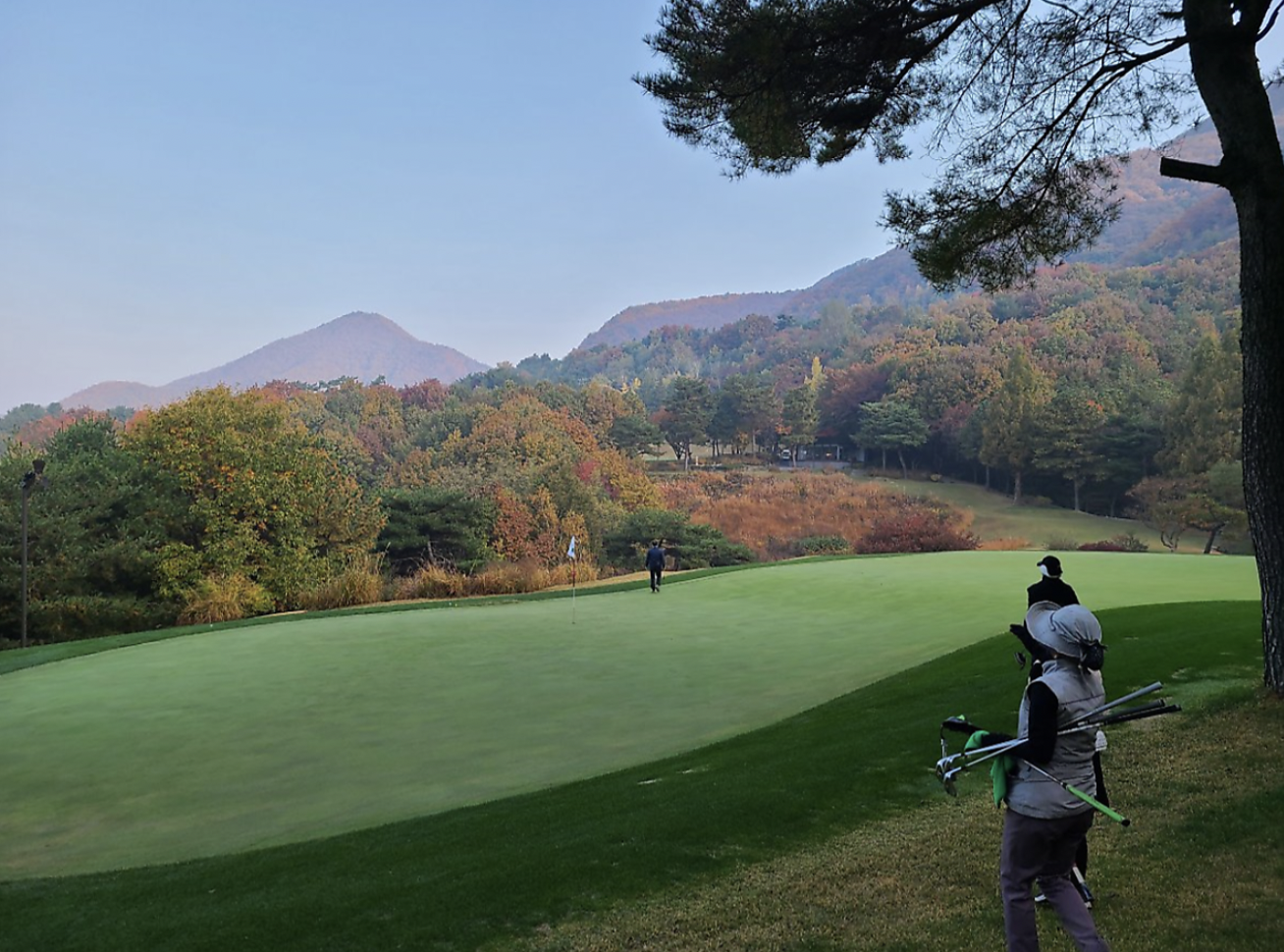
Super caddie in action. Not only does she memorize who uses which clubs and wedges for what
shots, she carries up to 12 clubs at a time for your convenience. Bravo.
Caddies also play a pivotal role in Korean golf culture. Usually, a lone caddie is assigned to a foursome at the start of the round. They driving the cart, cleaning and fetching clubs for all four players, explaining the layout and potential dangers at each hole, and providing yardages, and reading the greens.
It is not an easy task to say the least, but that’s not nearly all. The caddies are also responsible for the safety of the golfers while on the course, and to ensure that the pace of play is maintained in a polite and professional manner (I’m sure they were the most ecstatic when the rule to tend the pin was eliminated). Without a doubt, the caddies here are the true unsung heroes behind the recent growth spurt of golf in Korea. If it were not for them, I know that most of us would be either lost on course
or stuck behind first-timers struggling to play 18 under 6-hours. They deserve every penny they earn.
So there you have it. If speeding up play really helps to grow the game of golf, then the local rules that I have described above will definitely make a difference.
Which one would you be willing to try? Which ones will you fight to your dying breath as a golfer? Please comment below!
For a detailed look at a round of Korean style golf, check out my previous article: “A typical day of Korean golf, Gangnam style”
- LIKE94
- LEGIT3
- WOW8
- LOL3
- IDHT0
- FLOP1
- OB1
- SHANK4
Opinion & Analysis
The Wedge Guy: What really makes a wedge work? Part 2

In my last post, I explained the basic performance dynamics of “smash factor” and “gear effect” as they apply to your wedges and your wedge play success. If you missed that post, you can read it here.
At the end of that post, I promised “part 2” of this discussion of what makes a wedge work the way it does. So, let’s dive into the other two components of any wedge – the shaft and the grip.
It’s long been said that the shaft is “the engine of the golf club.” The shaft (and grip) are your only connection to all the technologies that are packed into the head of any golf club, whether it be a driver, fairway, hybrid, iron, wedge or even putter.
And you cannot ignore those two components of your wedges if your goal is optimizing your performance.
I’ve long been an advocate of what I call a “seamless transition” from your irons into your wedges, so that the feel and performance do not disconnect when you choose a gap wedge, for example, instead of your iron-set-matching “P-club.” In today’s golf equipment marketplace, more and more golfers are making the investment of time and money to experience an iron fitting, going through trial and error and launch monitor measuring to get just the right shaft in their irons.
But then so many of those same golfers just go into a store and choose wedges off the retail display, with no similar science involved at all. And that’s why I see so many golfers with a huge disconnect between their custom-fitted irons, often with lighter and/or softer graphite or light steel shafts . . . and their off-the-rack wedges with the stock stiff steel ‘wedge flex’ shaft common to those stock offerings.
If your wedge shafts are significantly heavier and stiffer than the shafts in your irons, it is physically impossible for you to make the same swing. Period.
To quickly improve your wedge play, one of the first things you can do is have your wedges re-shafted with the same or similar shaft that is in your irons.
There’s another side of that shaft weight equation; if you don’t have the forearm and hand strength of a PGA Tour professional, you simply cannot “handle” the same weight shaft that those guys play to master the myriad of ‘touch shots’ around the greens.
Now, let’s move on to the third and other key component of your wedges – the grips. If those are not similar in shape and feel to the grips on your irons, you have another disconnect. Have your grips checked by a qualified golf club professionals to make sure you are in sync there.
The one caveat to that advice is that I am a proponent of a reduced taper in your wedge grips – putting two to four more layers of tape under the lower hand, or selecting one of the many reduced taper grips on the market. That accomplishes two goals for your scoring.
First, it helps reduce overactive hands in your full and near-full wedge swings. Quiet hands are key to good wedge shots.
And secondly, it provides a more consistent feel of the wedge in your hands as you grip down for those shorter and more delicate shots around the greens. And you should always grip down as you get into those touch shots. I call it “getting closer to your work.”
So, if you will spend as much time selecting the shafts and grips for your wedges as you do choosing the brand, model, and loft of them, your scoring range performance will get better.
More from the Wedge Guy
- The Wedge Guy: What really makes a wedge work? Part 1
- The Wedge Guy: The easiest-to-learn golf basic
- The Wedge Guy: Golf mastery begins with your wedge game
- LIKE3
- LEGIT3
- WOW0
- LOL1
- IDHT1
- FLOP0
- OB0
- SHANK4
19th Hole
Vincenzi’s 2024 Wells Fargo Championship betting preview: Tommy Fleetwood ready to finally land maiden PGA Tour title

The PGA Tour season ramps back up this week for another “signature event,” as golf fans look forward to the year’s second major championship next week.
After two weaker-field events in the Zurich Classic and the CJ Cup Byron Nelson, most of the best players in the world will head to historic Quail Hollow for one of the best non-major tournaments of the year.
Last season, Wyndham Clark won the event by four shots.
Quail Hollow is a par-71 measuring 7,521 yards that features Bermudagrass greens. The tree-lined, parkland style course can play quite difficult and features one of the most difficult three-hole stretches in golf known as “The Green Mile,” which makes up holes 16-18: two mammoth par 4s and a 221-yard par 3. All three holes have an average score over par, and water is in play in each of the last five holes on the course.
The field is excellent this week with 68 golfers teeing it up without a cut. All of the golfers who’ve qualified are set to tee it up, with the exception of Scottie Scheffler, who is expecting the birth of his first child.
Past Winners at Quail Hollow
- 2023: Wyndham Clark (-19)
- 2022: Max Homa (-8)
- 2021: Rory McIlroy (-10)
- 2019: Max Homa (-15)
- 2018: Jason Day (-12)
- 2017: Justin Thomas (-8) (PGA Championship)
- 2016: James Hahn (-9)
- 2015: Rory McIlroy (-21)
Key Stats For Quail Hollow
Strokes Gained: Approach
Strokes gained: Approach will be extremely important this week as second shots at Quail Hollow can be very difficult.
Total SG: Approach Over Past 24 Rounds
- Akshay Bhatia (+1.16)
- Tom Hoge (+1.12)
- Corey Conners (+1.01)
- Shane Lowry (+0.93)
- Austin Eckroat (+0.82)
Strokes Gained: Off the Tee
Quail Hollow is a long course on which it is important to play from the fairway. Both distance and accuracy are important, as shorter tee shots will result in approach shots from 200 or more yards. With most of the holes heavily tree lined, errant drives will create some real trouble for the players.
Strokes Gained: Off the Tee Past 24 Rounds:
- Ludvig Aberg (+0.73)
- Rory McIlroy (+0.69)
- Xander Schauffele (+0.62)
- Viktor Hovland (+0.58)
- Chris Kirk (+0.52)
Proximity: 175-200
The 175-200 range is key at Quail Hollow. Players who can hit their long irons well will rise to the top of the leaderboard.
Proximity: 175-200+ over past 24 rounds:
- Cameron Young (28’2″)
- Akshay Bhatia (29’6″)
- Ludvig Aberg (+30’6″)
- Sam Burns (+30’6″)
- Collin Morikawa (+30’9″)
SG: Total on Tom Fazio Designs
Players who thrive on Tom Fazio designs get a bump for me at Quail Hollow this week.
SG: Total on Tom Fazio Designs over past 36 rounds:
- Patrick Cantlay (+2.10)
- Rory McIlroy (+1.95)
- Tommy Fleetwood (+1.68)
- Austin Eckroat (+1.60)
- Will Zalatoris (+1.57)
Strokes Gained: Putting (Bermudagrass)
Strokes Gained: Putting has historically graded out as the most important statistic at Quail Hollow. While it isn’t always predictable, I do want to have it in the model to bump up golfers who prefer to putt on Bermudagrass.
Strokes Gained: Putting (Bermudagrass) Over Past 24 Rounds:
- Taylor Moore (+0.82)
- Nick Dunlap (+.76)
- Wyndham Clark (+.69)
- Emiliano Grillo (+.64)
- Cam Davis (+.61)
Course History
This stat will incorporate players that have played well in the past at Quail Hollow.
Course History over past 36 rounds (per round):
- Rory McIlroy (+2.50)
- Justin Thomas (+1.96)
- Jason Day (+1.92)
- Rickie Fowler (+1.83)
- Viktor Hovland (+1.78)
Wells Fargo Championship Model Rankings
Below, I’ve compiled overall model rankings using a combination of the five key statistical categories previously discussed — SG: Approach (27%), SG: Off the Tee (23%), SG: Total on Fazio designs (12%), Proximity: 175-200 (12%), SG: Putting Bermuda grass (12%), and Course History (14%).
- Wyndham Clark
- Rory McIlroy
- Xander Schauffele
- Shane Lowry
- Hideki Matsuyama
- Viktor Hovland
- Cameron Young
- Austin Eckroat
- Byeong Hun An
- Justin Thomas
2024 Wells Fargo Championship Picks
Tommy Fleetwood +2500 (DraftKings)
I know many out there have Tommy fatigue when it comes to betting, which is completely understandable given his lack of ability to win on the PGA Tour thus far in his career. However, history has shown us that players with Fleetwood’s talent eventually break though, and I believe for Tommy, it’s just a matter of time.
Fleetwood has been excellent on Tom Fazio designs. Over his past 36 rounds, he ranks 3rd in the field in Strokes Gained: Total on Fazio tracks. He’s also been incredibly reliable off the tee this season. He’s gained strokes in the category in eight of his past nine starts, including at The Masters, the PLAYERS and the three “signature events” of the season. Tommy is a golfer built for tougher courses and can grind it out in difficult conditions.
Last year, Fleetwood was the first-round leader at this event, firing a Thursday 65. He finished the event in a tie for 5th place.
For those worried about Fleetwood’s disappointing start his last time out at Harbour Town, he’s bounced back nicely after plenty of poor outings this season. His T7 at the Valero Texas Open was after a MC and T35 in his prior two starts and his win at the Dubai Invitational came after a T47 at the Sentry.
I expect Tommy to bounce back this week and contend at Quail Hollow.
Justin Thomas +3000 (DraftKings)
It’s been a rough couple of years for Justin Thomas, but I don’t believe things are quite as bad as they seem for JT. He got caught in the bad side of the draw at Augusta for last month’s Masters and has gained strokes on approach in seven of his nine starts in 2024.
Thomas may have found something in his most recent start at the RBC Heritage. He finished T5 at a course that he isn’t the best fit for on paper. He also finally got the putter working and ranked 15th in Strokes Gained: Putting for the week.
The two-time PGA champion captured the first of his two major championships at Quail Hollow back in 2017, and some good vibes from the course may be enough to get JT out of his slump.
Thomas hasn’t won an event in just about two years. However, I still believe that will change soon as he’s been one of the most prolific winners throughout his PGA Tour career. Since 2015, he has 15 PGA Tour wins.
Course history is pretty sticky at Quail Hollow, with players who like the course playing well there on a regular basis. In addition to JT’s PGA Championship win in 2017, he went 4-1 at the 2022 Presidents Cup and finished T14 at the event last year despite being in poor form. Thomas can return as one of the top players on the PGA Tour with a win at a “signature event” this week.
Cameron Young +3500 (DraftKings)
For many golf bettors, it’s been frustrating backing Cam Young this season. His talent is undeniable, and one of the best and most consistent performers on the PGA Tour. He just hasn’t broken through with a victory yet. Quail Hollow has been a great place for elite players to get their first victory. Rory McIlroy, Anthony Kim, Rickie Fowler and Wyndham Clark all notched their first PGA Tour win at Quail.
Throughout Cam Young’s career, he has thrived at tougher courses with strong fields. This season, he finished T16 at Riviera and T9 at Augusta National, demonstrating his preference of a tough test. His ability to hit the ball long and straight off the tee make him an ideal fit for Quail Hollow, despite playing pretty poorly his first time out in 2023 (T59). Young should be comfortable playing in the region as he played his college golf at Wake Forest, which is about an hour’s drive from Quail Hollow.
The 26-year-old has played well at Tom Fazio designs in the past and ranks 8th in the field in Strokes Gained: Total on those courses in his last 36 rounds. Perhaps most importantly, this season, Young is the best player on the PGA Tour in terms of proximity from 175-200 in the fairway, which is where a plurality and many crucial shots will come from this week.
Young is an elite talent and Quail Hollow has been kind to players of his ilk who’ve yet to win on Tour.
Byeong Hun An +5000 (FanDuel)
Byeong Hun An missed some opportunities last weekend at the CJ Cup Byron Nelson. He finished T4 and played some outstanding golf, but a couple of missed short putts prevented him from getting to the winning score of -23. Despite not getting the win, it’s hard to view An’s performance as anything other than an overwhelming success. It was An’s fourth top-ten finish of the season.
Last week, An gained 6.5 strokes ball striking, which was 7th in the field. He also ranked 12th for Strokes Gained: Approach and 13th for Strokes Gained: Off the Tee. The South Korean has been hitting the ball so well from tee to green all season long and he now heads to a golf course that should reward his precision.
An’s driver and long irons are absolute weapons. At Quail Hollow, players will see plenty of approach shots from the 175-200 range as well as some from 200+. In his past 24 rounds, Ben ranks 3rd in the field in proximity from 175-200 and 12th in proximity from 200+. Playing in an event that will not end up being a “birdie” fest should help An, who can separate from the field with his strong tee to green play. The putter may not always cooperate but getting to -15 is much easier than getting to -23 for elite ball strikers who tend to struggle on the greens.
Winning a “signature event” feels like a tall task for An this week with so many elite players in the field. However, he’s finished T16 at the Genesis Invitational, T16 at The Masters and T8 at the Arnold Palmer Invitational. The 32-year-old’s game has improved drastically this season and I believe he’s ready to get the biggest win of his career.
- LIKE8
- LEGIT4
- WOW1
- LOL1
- IDHT0
- FLOP0
- OB0
- SHANK1
19th Hole
Vincenzi’s LIV Golf Singapore betting preview: Course specialist ready to thrive once again

After another strong showing in Australia, LIV Golf will head to Sentosa Golf Club in Singapore looking to build off of what was undoubtedly their best event to date.
Sentosa Golf Club sits on the southern tip of Singapore and is one of the most beautiful courses in the world. The course is more than just incredible scenically; it was also rated 55th in Golf Digest’s top-100 courses in 2022-2023 and has been consistently regarded as one of the best courses in Asia. Prior to being part of the LIV rotation, the course hosted the Singapore Open every year since 2005.
Sentosa Golf Club is a par 71 measuring 7,406 yards. The course will require precise ball striking and some length off the tee. It’s possible to go low due to the pristine conditions, but there are also plenty of hazards and difficult spots on the course that can bring double bogey into play in a hurry. The Bermudagrass greens are perfectly manicured, and the course has spent millions on the sub-air system to keep the greens rolling fast. I spoke to Asian Tour player, Travis Smyth, who described the greens as “the best [he’s] ever played.”
Davis Love III, who competed in a Singapore Open in 2019, also gushed over the condition of the golf course.
“I love the greens. They are fabulous,” the 21-time PGA Tour winner said.
Love III also spoke about other aspects of the golf course.
“The greens are great; the fairways are perfect. It is a wonderful course, and it’s tricky off the tee.”
“It’s a long golf course, and you get some long iron shots. It takes somebody hitting it great to hit every green even though they are big.”
As Love III said, the course can be difficult off the tee due to the length of the course and the trouble looming around every corner. It will take a terrific ball striking week to win at Sentosa Golf Club.
In his pre-tournament press conference last season, Phil Mickelson echoed many of the same sentiments.
“To play Sentosa effectively, you’re going to have a lot of shots from 160 to 210, a lot of full 6-, 7-, 8-iron shots, and you need to hit those really well and you need to drive the ball well.”
Golfers who excel from tee to green and can dial in their longer irons will have a massive advantage this week.
Stat Leaders at LIV Golf Adelaide:
Fairways Hit
1.) Louis Oosthuizen
2.) Anirban Lahiri
3.) Jon Rahm
4.) Brendan Steele
5.) Cameron Tringale
Greens in Regulation
1.) Brooks Koepka
2.) Brendan Steele
3.) Dean Burmester
4.) Cameron Tringale
5.) Anirban Lahiri
Birdies Made
1.) Brendan Steele
2.) Dean Burmester
3.) Thomas Pieters
4.) Patrick Reed
5.) Carlos Ortiz
LIV Golf Individual Standings:
1.) Joaquin Niemann
2.) Jon Rahm
3.) Dean Burmester
4.) Louis Oosthuizen
5.) Abraham Ancer
LIV Golf Team Standings:
1.) Crushers
2.) Legion XIII
3.) Torque
4.) Stinger GC
5.) Ripper GC
LIV Golf Singapore Picks
Sergio Garcia +3000 (DraftKings)
Sergio Garcia is no stranger to Sentosa Golf Club. The Spaniard won the Singapore Open in 2018 by five strokes and lost in a playoff at LIV Singapore last year to scorching hot Talor Gooch. Looking at the course setup, it’s no surprise that a player like Sergio has played incredible golf here. He’s long off the tee and is one of the better long iron players in the world when he’s in form. Garcia is also statistically a much better putter on Bermudagrass than he is on other putting surfaces. He’s putt extremely well on Sentosa’s incredibly pure green complexes.
This season, Garcia has two runner-up finishes, both of them being playoff losses. Both El Camaleon and Doral are courses he’s had success at in his career. The Spaniard is a player who plays well at his tracks, and Sentosa is one of them. I believe Sergio will get himself in the mix this week. Hopefully the third time is a charm in Singapore.
Paul Casey +3300 (FanDuel)
Paul Casey is in the midst of one of his best seasons in the five years or so. The results recently have been up and down, but he’s shown that when he’s on a golf course that suits his game, he’s amongst the contenders.
This season, Casey has finishes of T5 (LIV Las Vegas), T2 (LIV Hong Kong), and a 6th at the Singapore Classic on the DP World Tour. At his best, the Englishman is one of the best long iron players in the world, which makes him a strong fit for Sentosa. Despite being in poor form last season, he was able to fire a Sunday 63, which shows he can low here at the course.
It’s been three years since Casey has won a tournament (Omega Dubai Desert Classic in 2021), but he’s been one of the top players on LIV this season and I think he can get it done at some point this season.
Mito Pereira +5000 (Bet365)
Since Mito Pereira’s unfortunate demise at the 2022 PGA Championship, he’s been extremely inconsistent. However, over the past few months, the Chilean has played well on the International Series as well as his most recent LIV start. Mito finished 8th at LIV Adelaide, which was his best LIV finish this season.
Last year, Pereira finished 5th at LIV Singapore, shooting fantastic rounds of 67-66-66. It makes sense why Mito would like Sentosa, as preeminent ball strikers tend to rise to the challenge of the golf course. He’s a great long iron player who is long and straight off the tee.
Mito has some experience playing in Asia and is one of the most talented players on LIV who’s yet to get in the winner’s circle. I have questions about whether or not he can come through once in contention, but if he gets there, I’m happy to roll the dice.
Andy Ogletree +15000 (DraftKings)
Andy Ogletree is a player I expected to have a strong 2024 but struggled early in his first full season on LIV. After failing to crack the top-25 in any LIV event this year, the former U.S. Amateur champion finally figured things out, finished in a tie for 3rd at LIV Adelaide.
Ogletree should be incredible comfortable playing in Singapore. He won the International Series Qatar last year and finished T3 at the International Series Singapore. The 26-year-old was arguably the best player on the Asian Tour in 2023 and has been fantastic in the continent over the past 18 months.
If Ogletree has indeed found form, he looks to be an amazing value at triple-digit odds.
- LIKE3
- LEGIT3
- WOW1
- LOL2
- IDHT0
- FLOP2
- OB0
- SHANK0
-

 19th Hole3 weeks ago
19th Hole3 weeks agoJustin Thomas on the equipment choice of Scottie Scheffler that he thinks is ‘weird’
-

 19th Hole3 weeks ago
19th Hole3 weeks ago‘Absolutely crazy’ – Major champ lays into Patrick Cantlay over his decision on final hole of RBC Heritage
-

 19th Hole2 weeks ago
19th Hole2 weeks agoLET pro gives detailed financial breakdown of first week on tour…and the net result may shock you
-

 19th Hole3 days ago
19th Hole3 days agoReport: LIV star turns down PGA Championship invite due to ‘personal commitments’
-

 19th Hole1 week ago
19th Hole1 week agoGary Player claims this is what ‘completely ruined’ Tiger Woods’ career
-

 Whats in the Bag2 weeks ago
Whats in the Bag2 weeks agoTeam McIlowry (Rory McIlroy, Shane Lowry) winning WITBs: 2024 Zurich Classic
-

 Equipment1 week ago
Equipment1 week agoGolf fans left surprised by LIV’s choice of course for its 2024 individual championship event
-

 Equipment2 days ago
Equipment2 days agoDetails on Justin Thomas’ driver switch at the Wells Fargo Championship









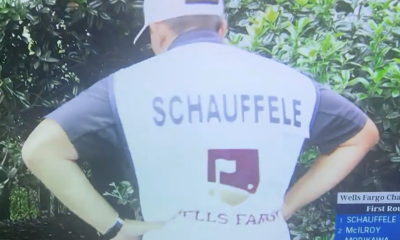



















Daddygreen
Apr 24, 2022 at 5:28 pm
Grow the game=make more money. That’s all you care about…even if it’s watered down.
L
Apr 22, 2022 at 3:54 pm
Keep that game there, don’t let them export to the rest of the world. Gimme circle? Ridiculous. Can’t walk in a reasonable amount of time? Don’t build courses there. Sheesh
JL
Apr 22, 2022 at 3:52 pm
Everything at the Korean golf courses were copied from Japan, practically. Same mountain terrains, multi-person cart. Wicked OBs and tight fairways. The gimme circle was tested but scrapped because people wanted to get better at actually playing than be given something. Though it’s a great idea for pace of play, especially when the greens have wicked slopes and can lead to multiple putts, but people need to be allowed to play the game too.
Growing the game? Not like this, just to pump people out there with quick pace just so that the club and industry can make money? No way! Ridiculous.
But yeah accuracy of your shots is important and should be encouraged. lol
geohogan
Apr 21, 2022 at 12:36 pm
If these are the types of golf courses Korean pros grew up playing, then
maybe this help explains oeverwhelming dominance /success on the LPGA tour.
blackbd
Apr 20, 2022 at 2:53 pm
I found this article interesting but not sure if the author is trying to address the distance debate, speed of play or growing the game or all 3? I presume all 3 but not sure how it was all tied together? Also, that kind of super narrow and penal golf seems not fun. Not even sure I want to watch pros play that style other than once or twice a year.
CrashTestDummy
Apr 20, 2022 at 10:25 am
Interesting article. It always interests me how other countries play golf differently. I have played a few times in Asia before and the experience is totally different than the US.
From what I have seen, Korean golf courses look very tough and narrow. I watch a lot of Korean golf shows and you can tell the good player’s ball striking is very accurate, but you have to in order to score on Korean courses. Not like most of the “grip it and rip” it type courses in the US. The gimme circle makes up a little for the toughness of the courses. But definitely not enough. Lol.
neil
Apr 20, 2022 at 12:31 pm
lived in Korea 4 years
weather is great at least for a scotsman.basically 2 seasons warm and cold
Can be 40f one day 70 or higher the next until November then cold again..
we played through the winter down south near Busan.cold but comfortable miles better than a scottish winter
DaeGunn
Apr 20, 2022 at 10:10 am
Golf becomes No.1 sport in Korea. People in general can actually play (not just watch) and enjoy golf, compared with other watching-only sports. Fast growing golf related businesses in Korea may affect the acquisition of big name golf companies by Korean related funds or companies.
As a Korean-American, I heard a lot about Korean’s unique golf course settings nicely summarized in this article. At first, I thought those are very absurd. But as this article explained, I now understand that those are understandable and necessary.
It would be good to know each region’s or country’s different or unique golf cultures.
JungleJimbo
Apr 20, 2022 at 9:28 am
Hi James Chang: Thank you, for your Fabulously-written article that i enjoyed immensely! The Korean approach to golf is intriguing, and GolfWRX is all the better for your series of articles (and unique, i.e. i don’t see this Korean perspective on many other mainstream golf publications). “?????”!
Jub
Apr 20, 2022 at 8:55 am
No! Stop growing the game!
MhtLion
Apr 20, 2022 at 12:51 pm
That’s what I’m saying.
Garrett
Apr 22, 2022 at 12:48 pm
Im with you on that. not enough golf courses or CC around me to even get decent times. STOP GROWING THE GAME
Rascal
Apr 22, 2022 at 1:49 pm
Me! Me! Me!!!!
Waaaaaahh!